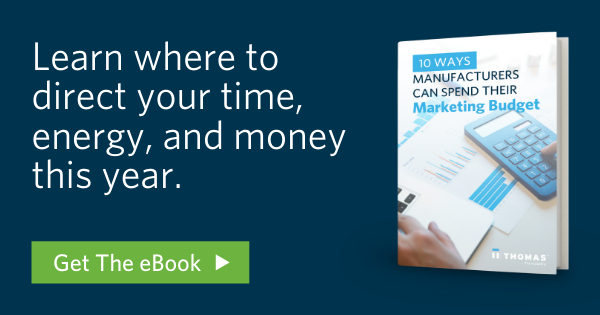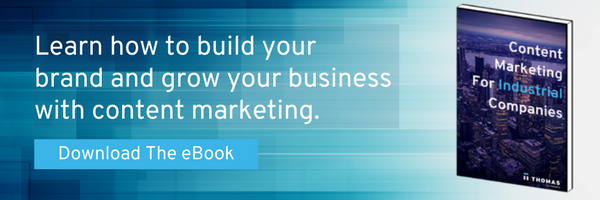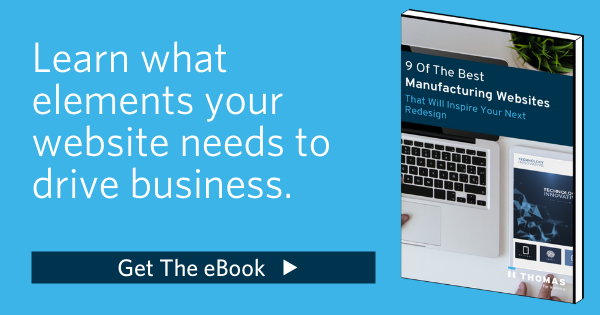For Manufacturers: 11 Steps To Begin Your First PPC Campaign
Sam Treinish September 6, 2019
More manufacturers and industrial companies are investing their time and budget into paid marketing — it's a model that targets consumers online based on their interests or intent using different tactics like display ads or pay-per-click (PPC). PPC is a must-have for any inbound strategy — over time, B2B marketers are able to effectively reach their target audience and drive leads based on their searches. One of the most compelling characteristics of paid marketing is the tremendous amount of data you’re able to collect in order to make decisions and improve the performance of your campaigns. The more you learn about your audience, the easier you can market and sell to them effectively. Who doesn't want that for their business' bottom line? But getting a conversion through PPC that justifies the expense takes careful planning and precise execution.
Also referred to as "cost-per-click" or CPC, PPC can be challenging to begin. Especially when you don't have any data, how do you get started? We put together this list of 12 PPC tips that will give beginners the best chance of starting off on the right foot. And we'll address one of the main challenges of managing PPC — how to target business customers when there is a large volume of consumer or retail traffic searching similar keywords.
 Tip 1: B2B PPC Campaigns Need To Be Specific
Tip 1: B2B PPC Campaigns Need To Be Specific
Some companies are blessed with industry-specific and commonly known terminology that only a business customer would be searching. You can end up squandering your budget on the wrong type of traffic and inundating your sales team with low quality leads. Some companies can quickly knock out a keyword list and be comfortable knowing that anybody searching for those keywords is a business customer looking for products or services they offer. It’s much more challenging for companies that serve business customers in a market that has a large eCommerce or consumer component or niche manufacturing and industrial companies.
The best advice when you are building out your keywords is to overdo it. Include as many long tail keywords as you reasonably can with as many modifiers as you can conjure. In many cases you will need to skip the general, high volume keywords all together and focus your keyword list solely on the mid and long tail. That does not mean you should be including lots of short, general keywords that are only somewhat related to your business, products and services. It means you should come up with as many keywords as possible that are extremely specific and targeted toward your business. You will be sacrificing traffic volume but you’ll likely improve the quality of traffic and attract users that are more likely to convert.
Refresh Your Industrial Terminology: 7 Terms You Need To Know About PPC
For example, a job shop that specializes in screw machining may be tempted, in the interest of saving time on the front end, to launch a campaign using a handful of general keywords like ‘machining,' ‘CNC machining' and ‘screw machining’ with loose match types in order to capture any long tail traffic. However, it’s absolutely worth spending the time to systematically build out as many of the long tail searches you hope to capture as possible. This means including keywords with modifiers for materials, synonyms, processes, equipment types, capacity and more.

Let's look at it from your customer's perspective now. Think about the most general keywords a potential customer might use when looking for your products or services. If the search results they will get include a wide range of offerings for consumers and businesses at a wide range of price points, the first thing they are going to do is modify their search to something more specific. They’ll try again — like ‘aluminum CNC machining supplier’ or ‘swiss machining shops’ or ‘live tooling screw machining.’ Those are the keywords that will drive high quality traffic. Build keyword lists with modifying words like industrial, commercial, supplier, distributor, large, etc. and keywords with specific industry terminology. These kinds of keyword modifiers can often distinguish the knowledgeable, valuable business customer from the consumer masses.
Industrial companies new to PPC are more likely to launch a campaign with over 1,000 keywords. This allows you to begin collecting data right from the beginning on what specific searches are truly driving your traffic, costs and conversions. There will be no mystery about what role long tail searches are playing compared to high volume general keywords. In the future, when you may decide you need to sacrifice some volume in order to reduce costs and improve ROI, you’ll have all the information and data you need to make truly informed decisions at the keyword level. There is a significant time investment on the front end, but with what you’ll spend over the life of that campaign, the ability to make better decisions and improve campaign efficiency in the future will make that time well worth it.
Learn More: 10 Ways To Effectively Spend Your Marketing Budget
Here's another example — consider a specialty commercial vacuum equipment company. They may be able to drive a lot of traffic (and generate a lot of cost) with the keyword vacuums, but they are far more likely to generate a sale from a user that searched silica dust vacuum. Including only these mid and long tail keywords may mean that you cannot attract as much traffic as you would in a perfect world, but that traffic will be high quality and worth paying for.
We recommend building out keyword lists using Excel in order to build your list efficiently. Then that list can be bulk uploaded into your campaigns, saving a ton of time over working solely in the Adwords or Bing user interfaces.
Tip 2: Split Your Keywords Into Extremely Specific Ad Groups
Make sure you are also breaking up your keywords into very specific ad groups based on modifying elements in your keywords like material, process, equipment, capacity, etc. This will benefit you in a couple key ways in the future.
First, it will provide a lot of ease and clarity in reporting in the future. You’ll be able to easily pull ad group reports that will simply and clearly show you which types of keywords are driving search volume, clicks, cost and conversions. There won’t be any difficulty identifying whether searches that specify they are looking for a supplier that can work with aluminum are more or less valuable than searches looking for a shop that can work with bronze.
Second, ad copy is set at the ad group level. Breaking keywords out into very targeted and specific ad groups allows you to present very targeted and specific ad copy. If somebody has specified in their search that they need a supplier that is able to work on prototypes, your ad copy should be talking about working with prototypes. It will have a huge impact on your click through rate which means you won’t have to rely solely on aggressive bidding and top ad positions in order to capture the traffic you are after
Tip 3: Use Broad Match Modifier For Your Long Tail Keywords
For the long tail keywords in your campaigns, we suggest using Broad Match Modifier and requiring that each individual word in your keywords be included in the query (using the ‘+’ sign syntax) in order to trigger your ad. Try to avoid using plain old Broad Match because it just matches to too many unrelated searches. But by using Broad Match Modifier on long tail keywords, you can be sure that any searches you are appearing for are a pretty qualified match that you wouldn’t want to miss. At the same time, Broad Match Modifier is inclusive enough enough that you don’t risk missing out on traffic from searches with slight variations that may be filtered out with Exact Match.

Tip 4: Use Multiple Match Types For Your Most General Keywords
For your shorter, more general keywords, we recommend including variations of those words in [Exact], “Phrase” and +Modified +Broad +Match. Often times, particularly with more general keywords that will be high volume, there will be substantial differences in traffic quality and performance based on match type. By including them all from the start you’ll be segmenting that traffic and can increase bids, decrease bids or pause poor performing variations in the future based on the data you collect.
Tip 5: Include Branded Keywords
There is an ongoing debate on whether to include branded keywords like your own company name or URL. The argument against is basically: “Why would I serve ads for these keywords and pay for those clicks if I am already in the first organic position?” Well, it generally does make sense to advertise on branded terms for a number of reasons. The traffic tends to be cheap and the conversion rates astronomical, so why not capture as much real estate as possible on results pages for your branded terms? In many cases you’ll find that competitors are also bidding on your branded terms, which means you can’t risk ceding those most valuable of visitors to competitors. Plus, your quality scores on those keywords is going to be great which will likely pull up your account’s quality score and strengthen non-branded keyword performance. Include those keywords from the start and optimize your campaigns after you've gathered enough data.
Tip 6: Don’t Forget The Most Obvious Negative Keywords
Over time you’ll have the opportunity to pour through search term data and cultivate a long list of negative keywords to help you weed out irrelevant and low quality impressions. It will take a long time to build that list, and you should devote time to it. But as you’re just getting started, be sure to spend some time thinking about the big, obvious ones that can give you a big CTR advantage right off the bat. For example, if you are selling electrical transformers, you should realize that there is going to be a lot of traffic out there searching for things related to the Transformers action figures and movies. You’ll get off to a much better start if you take a few minutes to include negatives for ‘movie,’ ‘action figure,’ ‘cartoon,’ ‘toys,’ ‘actors,’ ‘Shia LaBeouf,’ ‘Megan Fox,’ ‘IMDB,’ etc. Take some time to think about what overlap your keywords may have with other non-related topics with a lot of search volume. It’s an easy and painless step with a lot of benefit, but it’s also easy to overlook.
Tip 7: Opt Out Of The Display Network
As a default, Google and Bing will opt you into the Display Network as well as the Search Network. It’s a deplorable practice designed to get you to spend (or waste) your money. We don't recommend opting into both the Search and Display Networks with the same campaigns. They are different beasts that should be ALWAYS be managed and reported separately — unless you have search engine marketing experts to help you.
Tip 8: Start A Small Ad Copy Test On Your Most General And High Volume Ad Groups
Try making it explicitly clear in your ad copy that you exclusively serve business customers. The goal is to actively deter consumer and retail users from clicking your ad. It can be counterintuitive that you would include language intended to ward off potential site traffic. But in PPC you are paying by the click, so you’re better off if the users that are unlikely to be good customers avoid your ads in the first place.
In some cases you may find that these ads have too low of a click through rate, which can hurt your Quality Score — and that shouldn’t be ignored. I would suggest the remedy for that is narrowing your keyword list to prevent those impressions from happening in the first place rather than trying to rewrite your ads to make them more appealing to consumer traffic that will probably never offer you profitable sales growth.
Learn More: 10 Ways Manufacturers Are Effectively Spending Their Budget
You have very few characters to work with in the body text of your ad copy (90 characters), which means you have to choose your words very wisely. The best way to do that is to test different variations; however, when you are getting started it probably isn’t worth the time to do a very large test with multiple ad variations in each and every ad group.
Related Resource: 30 Industrial Lead Generation Tips, Tricks, and Ideas
We recommend starting off with a small test just in a few of your most general ad groups which are likely to be the highest volume. You might include several variations that each emphasize something different like ‘Free Shipping,’ ‘Fast Turnaround,’ ’30+ Years Experience,’ or ‘Fast Quotes.’ You can then see which ads are performing better in your test and implement the best phrases more broadly across the entire account. In the future, it will likely be a good idea to conduct more comprehensive and thorough ad copy testing, but we recommend starting with a small scale test like this right off the bat. It can point you in the right direction quickly with a minimal amount of time and effort.
Just make sure these headlines and descriptions align to the landing page your ad is linking to. You don't want it to be misleading or it will affect the quality of your traffic and lead conversion. Content marketing rule of thumb: Everything has to be aligned.
Tip 9: Show Ads Evenly For 90 Days
When you use the default setting to ‘Optimize for Clicks’, Google seems to start favoring one ad variation over others a bit more quickly than we're comfortable with. Since you’ve taken the time to create multiple ad variations to test ad copy, it’s worth giving them time to collect statistically significant data before settling on one. By changing the default setting to ‘Show ads more evenly for at least 90 days, then optimize,’ you are sure to collect enough data for any conclusions to be justified. Plus, if you don’t get around to analyzing your results and choosing an ad variation yourself in a timely manner, you can sleep soundly knowing that after 90 days Google will jump in and make the decision for you based on the data you’ve collected over that time.
Tip 10: Device Setting And Bid Modifiers
Setting bid modifiers to increase or decrease bids based on whether the user is on a desktop or mobile device should be a very data driven process. But when you are first launching you won’t have any data on which to rely. That doesn’t mean you can’t make some informed guesses and try to get started in the right direction. Just think about your site and what you are hoping your customers will do on it. If you don’t currently have a mobile-optimized site (which you should) or your conversion process involves filling out a lengthy and detailed RFQ, you can probably guess that traffic from mobile is less likely to convert. Set a modifier percentage to reduce bids for mobile visitors based off of your buyers' behavior.
Related Info: 7 Quick Ways To Check If Your Website Is Out Of Date
Though the difference is shrinking all the time, most businesses still find that conversion rates are lower for mobile traffic. It stands to reason that you would therefore want to pay less for that traffic. However, if your most valuable conversion activity is a download off your fancy new mobile app, you may be willing to pay a premium for mobile traffic. Think about your business, your site and the nature of your conversions and take a guess at how the value of each type of traffic differs. Then implement bid modifiers accordingly. Just be sure not to let those assumptions control your bid strategy once you do have data that can inform the decision much more accurately.
It's also important to note that buying habits are changing and the digital transformation of sales and marketing are no longer the same just a few years ago. Smart manufacturers and industrial companies are shifting their traditional growth methods with a stronger online focus, so in order for your PPC efforts to work effectively, you need an updated website and strong content marketing as the foundation for your campaigns.
Tip 11: Adjust Your Ad Scheduling
Another method to improve the likelihood of attracting business customers is to adjust your ad scheduling or set bid modifiers by time-of-day and day-of-week. If you are a B2B company that offers little to people in their leisure time, it’s likely you’ll see better conversion rates during business hours than at night or on weekends. Consequently you’re likely to pay more to acquire traffic during business hours. But that doesn’t mean there is no value to traffic that comes through on nights and weekends. People may still be searching for your keywords during those times. That's why it's important to understand the personas you are targeting. Learning about the "type" of ideal customer you are trying to reach helps fine-tune your content, messaging, and timing of it all.
Learn More: How To Create Buyer Personas For Industrial Marketing Campaigns
If it applies based off of your persona behavior, set bid modifiers so that you still attract that off-hours traffic but are paying less for it. Conversely, if you’re business is attractive to hobbyists (like custom auto parts) and those are good customers for you, consider paying more for traffic on nights and weekends. Just don’t forget to go back and make more precise judgments once you’ve collected the data to do so.
Business categories with little or no consumer overlap will likely see volume decrease during non-business hours but conversion rates will often stay the same. The thinking goes that if someone is searching for your products or services on a weekend then clearly they are interested during that time frame.
However, where consumer overlap is a challenge, many of the high quality business customers will vanish during non-business hours and the search volume that remains will largely be low value retail consumers. Monitor your conversion rates and the quality of the leads that you generate in business versus non-business hours. You may find that it makes sense to bid less aggressively or to pause some campaigns completely during certain time periods.
Get Started With A PPC Campaign
These are just a few of the ways we try to seek out the high quality business customers hiding in a sea of consumer searches. This is by no means an exhaustive list of all the uncertainties you’ll face when launching a new paid search account — it can get more complex the bigger your business grows. But your performance will improve and the leads will convert if you take the time to set everything right and monitor the campaigns periodically. Not sure how to research the best keywords for your manufacturing business? Contact our team of manufacturing marketing experts.
Did you find this useful?












